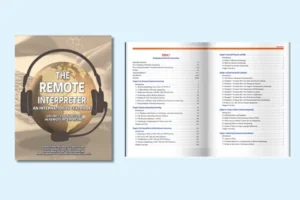This blog, written by Katharine Allen, was originally shared on Slator’s website on August 24th, 2023.
More Than Just Buzz: Why the Remote Interpreter Textbook Is an Important Milestone – Slator
By now, you may have seen announcements on social media and in language industry media outlets celebrating the publication of The Remote Interpreter: An International Textbook and thought, “So what?” Given the profound impact of interpreting in key moments of human experience, such as the doctor attending the birth of a child to diplomats negotiating the end of a brutal war, a standardized and widely disseminated body of knowledge matters. Just as the doctor learns and practices her profession based on agreed-upon principles and practices, so too should the interpreter.
Enter The Remote Interpreter, the first textbook to provide comprehensive guidance and globally relevant benchmarks for the remote interpreting modality. The textbook is the result of a four-year collaboration between seven primary authors and five contributing authors, all experts in remote interpreting. It represents the collective knowledge and wisdom of this young field.
Traditionally, interpreters have entered the field anchored to their geographic location, with the assumption that they will work where they live and engage with local clients who share the same cultural and institutional reality in schools, hospitals, businesses, and courtrooms. Textbooks such as of Court Interpretation: Theory, Policy and Practice and The Community Interpreter: An International Textbook have been highly consequential in defining the scope of professional practice for onsite legal and medical interpreters in the United States. These are the cornerstones to building legitimacy and recognition for the still-young interpreting specializations.
Remote interpreting, however, is a rapidly growing arena that has largely bypassed these traditional pathways and cornerstones to professionalization. The lightning-fast spread of technology facilitating real-time multilingual communication, sustained by increasing global immigration and boosted exponentially by the pandemic, has created a large, globalized workforce operating across international boundaries without easy access to traditional interpreter education and training.
At the same time, remote interpreting customers clamor for high levels of interpreter quality, consistency, and expertise. The solution, outside of conference interpreting, has been for language service companies to provide interpreter training. As a comparison, it would be like hospitals training nurses or schools being responsible for educating teachers.
Language service companies being solely responsible for training remote interpreters, all good intentions aside, is problematic. The primary training programs for remote interpreters are private, and there needs to be a public consensus on what skills and knowledge remote interpreters should have. The result is an interpreter workforce lacking uniform skills and inconsistent access to professional development resources. The deficiencies in this system can and do lead to real-life negative consequences.
For example, we live in an age of increasing natural disasters that impact local populations indiscriminately. Imagine an emergency room where providers are treating an influx of patients suffering injuries from a hurricane. They can access qualified medical interpreters for Spanish-speaking patients within seconds, using on-demand remote interpreting services. But when the providers need an interpreter for a Chuukese-speaking patient, they are put on hold for 25 minutes and end up relying on a family member to interpret because no on-demand Chuukese interpreter is available. The patient receives inferior care and has worse health outcomes. The hospital then lodges a complaint with the language service company for breaching its promise to provide on-demand Chuukese.
This is a common scenario in remote interpreting. Where companies can recruit, train, and fill the demand for languages with a high volume of speakers and available interpreters, such as Spanish or French, it’s easier to support the workforce and provide a quality service. The same service, however, is far more complicated to achieve across all language combinations. The bigger the divide between where the language speakers come from and how much or little they have in common, the more difficult it is to locate and prepare interpreters to be equally as skilled and able to handle the diverse settings they work in.
For all these reasons, The Remote Interpreter textbook comes at a pivotal moment for the global workforce tasked with ensuring effective multilingual communication worldwide. It is the first comprehensive attempt to provide a standardized approach to ethics, conduct, and key skills that the unique realities of interpreting remotely.

The table of contents for Volume 1 demonstrates the scope of knowledge required to capture the basics of the remote interpreting modality. It assumes the interpreter already has beginning skills training. By the end of Volume 1, the interpreter will have acquired the foundational body of knowledge to work remotely.

Volume 2, which is mostly complete, provides a deeper dive into remote simultaneous interpreting and the interpreting specializations, including conference, legal, healthcare, education, and business. It also tackles the advent of artificial intelligence and its impact on interpreting, as well as interpreter self-care.
The day may come when remote interpreting is an established branch of study at academic institutions around the world. In that case, language service providers will be able to set aside the burden they currently carry for training and professionalizing the remote interpreting workforce. In the meantime, The Remote Interpreter is an indispensable resource for practitioner self-study, as well as for academics advocating for future programs in remote interpreting and for the companies training remote interpreters today.
Key Takeaways
The Remote Interpreter textbook will help interpreters to:
- Acquire a standardized, vetted body of knowledge to do their job.
- Procure the appropriate technology to work remotely.
- Determine which ethics, laws, and practices are “correct” to apply for each session.
(For example, if they are taking medical calls, they will understand when to follow Canada’s strict prohibition against cultural mediation of any kind or when to adhere to the United States guidelines that permit addressing cultural barriers to communication.)
- Adapt interpreter protocols and etiquette to remote encounters.
- …and much more!
Interested in learning more about The Remote Interpreter? Watch the Boostlingo Webinar introducing the textbook.




